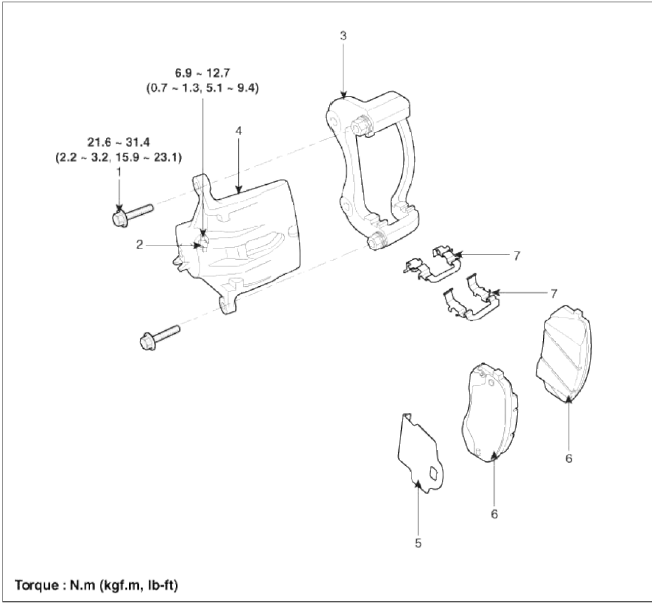Kia Sportage: Front Disc Brake
Components and Components Location
Components

- Guide rod bolt
- Bleed screw
- Caliper bracket
- Caliper body
- Inner pad shim
- Brake pad
- Pad retainer
Repair procedures
Removal
1. Remove the front wheel & tire.
Tightening torque: 88.3 ~ 107.9 N.m (9.0 ~ 11.0 kgf.m, 65.1 ~ 79.6 lb-ft)
2. Loosen the hose eyebolt (B) and caliper mounting bolts (C), then remove the front caliper assembly (A).
Tightening torque:
Brake hose to caliper (B): 24.5 ~ 29.4 N.m (2.5 ~ 3.0 kgf.m, 18.1 ~ 21.7 lb-ft)
Caliper assembly to knuckle (C): 78.5 ~ 98.1 N.m (8.0 ~ 10.0 kgf.m, 57.9 ~ 72.3 lb-ft)

3. Remove the front brake disc by loosening the screws (A).

Replacement
Front brake pads
1. Remove the brake hose mounting bracket bolt (A).

2. Loosen the guide rod bolt (B) and pivot the caliper (A) up out of the way.
Tightening torque: 21.6 ~ 31.4 N.m (2.2 ~ 3.2 kgf.m, 15.9 ~ 23.1 lb-ft)

3. Replace pad shim (D), pad retainers (C) and brake pads (B) in the caliper bracket (A).

Inspection
Front brake disc thickness check
1. Check the brake pads for wear and fade.
2. Check the brake disc for damage and cracks.
3. Remove all rust and contamination from the surface, and measure the disc thickness at 8 points, at least, of same distance (5mm) from the brake disc outer circle.
Brake disc thickness
[2WD]
- Standard : 26 mm (1.02 in)
- Service Limit: 24.4 mm (0.96 in)
[4WD]
- Standard : 28 mm (1.10 in)
- Service Limit: 26.4 mm (1.04 in)
Deviation: Less than 0.005 mm (0.0002 in)

4. If wear exceeds the limit, replace the discs arid pad assembly left and right of the vehicle.
Front Brake Pad Check
1. Check the pad wear. Measure the pad thickness and replace it, if it is less than the specified value.
Pad thickness
Standard value: 11 mm (0.43 in)
Service limit: 2.0 mm (0.0787 in)
2. Check that grease is applied, to sliding contact points and the pad and backing metal for damage.

Front brake disc runout check
1. Place a dial gauge about 5mm (0.2 in.) from the outer circumference of the brake disc, and measure the runout of the disc.
Brake disc runout
Limit: 0.025 mm (0.00098 in.) or less (new one)

2. If the runout of the brake disc exceeds the limit specification, replace the disc, and then measure the runout again.
3. If the runout does not exceed the limit specification, install the brake disc after turning it 180º and then check the runout of the brake disc again.
4. If the runout cannot be collected by changing the position of the brake disc, replace the brake disc.
Installation
1. Installation is the reverse of removal.
2. Use a SST (09581-11000) when installing the brake caliper assembly.

3. After installation, bleed the brake system. (Refer to Brake system bleeding)
READ NEXT:
 Rear Disc Brake
Rear Disc Brake
Components and Components Location
Components
Guide rod bolt
Bleed screw
Caliper bracket
Caliper body
Inner pad shim
Brake pad
Pad retainer
Repair procedures
Removal
1. R
 Components and ComponentsLocation | Removal - Repair procedures
Components and ComponentsLocation | Removal - Repair procedures
Components (1)
[Hand Type] / [Foot Type]
Parking brake pedal assembly
Front parking brake cable (Foot type only)
Equalizer assembly
Rear parking brake cable
Parkin
SEE MORE:
 Components and Components Location | Rear Shock Absorber
Components and Components Location | Rear Shock Absorber
Components Location
Sub frame
Assist arm
Upper arm
Lower arm
Trailing arm
Rear axle
Coil spring
Shock absorber
Drive shaft
Stabilizer
Differential carrier
Components
(2WD)
Sub frame
Lower arm
Trailing arm
 Automatic turn off function
Automatic turn off function
This vehicle is equipped with lights
throughout the vehicle to illuminate the
interior.
CAUTION
Do not use the interior lights for
extended periods when the engine is not
running.
It may cause battery discharge.
WARNING
Do not use the interior lights when driving
in the dark. Accidents c
Content
- Home
- Kia Sportage - Fifth generation (NQ5) - (2022-2025) - Owner's Manual
- Kia Sportage - Second generation (JEKM) (2005-2015) - Body Workshop Manual
- Kia Sportage Third generation (SL) - (2011-2016) - Service and Repair Manual
- Sitemap
- Top articles